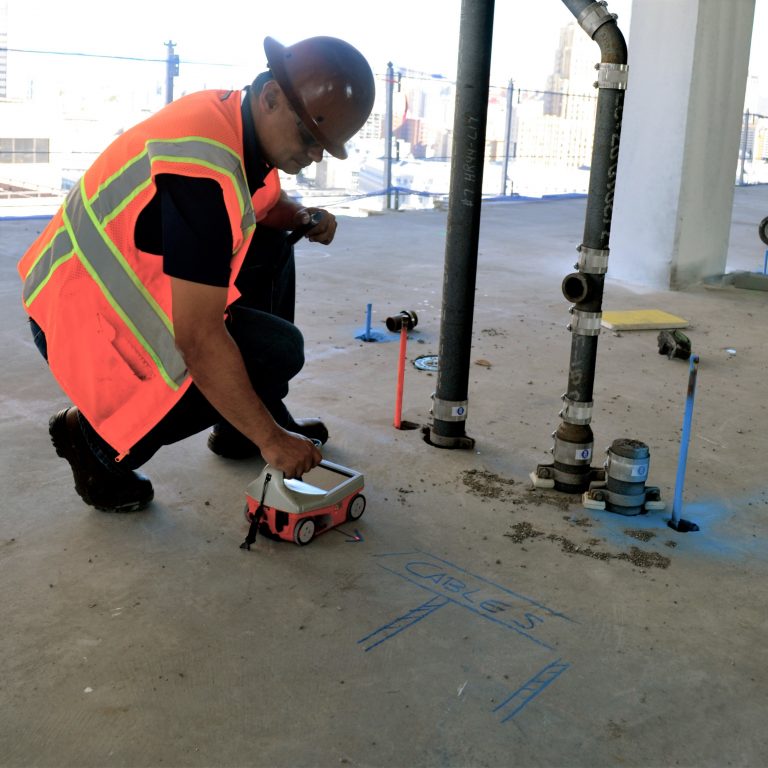Beyond the Surface Area: Leveraging Advanced Concrete Scanning Techniques for Unmatched Precision and Insight
Advanced concrete scanning methods have actually arised as important tools in this quest, using a look beneath the surface to reveal a world of vital insights. By utilizing innovative innovations, experts can discover abnormalities, analyze the problem of concrete structures, and make informed choices that form the training course of projects.
Importance of Advanced Concrete Scanning
The relevance of using innovative concrete scanning techniques depends on the unrivaled precision they supply for discovering sub-surface abnormalities and ensuring structural honesty. By utilizing advanced technologies such as ground-penetrating radar (GPR), electro-magnetic induction, and progressed finder imaging, building and construction professionals can delve underneath the surface of concrete structures with a level of precision that much surpasses standard inspection methods. Concrete Scanning. These strategies make it possible for the identification of surprise dangers like rebar corrosion, gaps, channels, or post-tension cables that can endanger the security and safety of a framework in time
In addition, advanced concrete scanning gives indispensable insights right into the total condition of a concrete aspect without the demand for intrusive measures, reducing the danger of triggering damage throughout the evaluation process. The ability to determine the specific place and depth of potential concerns permits targeted repairs and upkeep, ultimately extending the lifespan of the structure and enhancing its performance. Fundamentally, the significance of advanced concrete scanning can not be overemphasized in the realm of building and infrastructure maintenance, where accuracy and reliability are extremely important.
Kinds Of Cutting-Edge Technologies

Anomalies and Problem Detection

In addition to GPR, concrete scanning strategies like thermography and impact-echo testing are additionally efficient in detecting abnormalities and problems. By leveraging these advanced methods, professionals can proactively attend to architectural problems, guaranteeing the durability and safety of concrete frameworks.
Assessing Concrete Problem
Just how can engineers accurately examine the condition of concrete frameworks to ensure their durability and safety and security? Various advanced concrete scanning methods are employed for this objective. Ground-penetrating radar (GPR) is frequently made use of to analyze the internal structure of concrete, discovering voids, cracks, and other abnormalities that might compromise its toughness.
In addition, visual examination continues to be an essential component of concrete condition analysis. Designers aesthetically examine the surface for indications of damage, such as spalling, breaking, or discoloration. Combining non-destructive screening approaches with visual assessments enables a detailed analysis of concrete problem, allowing engineers to identify possible problems early and execute timely upkeep or repair work. By leveraging these sophisticated methods, engineers can guarantee the lasting durability and safety of concrete frameworks.
Enhancing Decision-Making Procedures
In the realm of infrastructure administration, maximizing decision-making procedures is essential for guaranteeing the effective upkeep and long life of concrete frameworks. Boosted decision-making procedures in concrete monitoring include utilizing sophisticated scanning techniques to gather thorough information on the problem of frameworks. By leveraging technologies such as ground-penetrating radar and 3D imaging, stakeholders can make you can look here enlightened choices pertaining to repair work, reinforcement, or replacement methods.
These progressed scanning strategies provide important understandings into the inner composition of concrete, identifying possible problems such as voids, cracks, or rust that may not show up externally. This level of comprehensive info enables proactive upkeep preparation, lessening the danger of structural failings and raising the overall life expectancy of concrete frameworks.
Additionally, by integrating electronic documentation and analysis devices into the decision-making procedure, stakeholders can track the development of concrete conditions with Discover More Here time, making it possible for anticipating maintenance approaches and enhancing source appropriation. Eventually, the combination of sophisticated concrete scanning strategies improves decision-making processes by providing unparalleled precision, understanding, and effectiveness in framework management.
Verdict
To conclude, advanced concrete scanning techniques provide unmatched precision and insight in detecting abnormalities, issues, and analyzing the condition of concrete frameworks. By leveraging sophisticated innovations, decision-making procedures can be enhanced, leading to more informed and effective options for preserving and repairing concrete facilities. These techniques play a vital function in guaranteeing the security and long life of concrete structures, making them a crucial tool in the field of construction and design.
Furthermore, progressed concrete scanning offers indispensable understandings right into the general condition of a concrete element without the need for invasive steps, reducing the risk of causing damage throughout the evaluation process - Concrete Scanning. One more ingenious innovation is 3D X-ray scanning, which offers comprehensive photos of the inner structure of concrete, providing valuable details without the requirement for destructive testing. Furthermore, Concrete Cover Meters are made use of to gauge the density of concrete cover over support bars precisely. Enhanced decision-making procedures in concrete management include using innovative scanning strategies to gather comprehensive information on the problem of frameworks.In verdict, advanced concrete scanning methods use unparalleled precision and insight in identifying anomalies, problems, and examining the problem of concrete frameworks